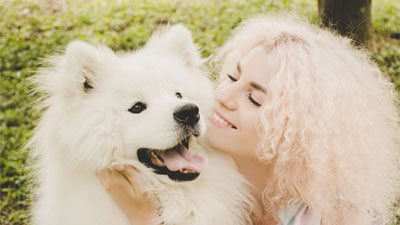- Size
- Smallest
- Small
- Small to Medium
- Medium
- Large
- Giant
- Characteristics
- Smartest
- Hypoallergenic
- Fluffy
- Best Guard
- Best Family
- Best for Kids
- Low Shedding
- Healthiest
- Police Dogs
- Most Calm
- Quietest
- Color
- White
- Black
- Grey
- Brown
- Blue
- Red
- Coat
- Hairless
- Short
- Long
- Origin
- Japan
- China
- Australia
- Germany
- Italy
- United States
- France
- Group
- Hound
- Terrier
- Herding
- Toy
- Working
- Sporting
What Does It Mean When a Dog is Cowering?

Photo by Rebecca Campbell on Unsplash
Dogs have evolved to be highly attuned to their surroundings and have developed various ways of communicating their emotions and needs. One such behavior that dogs often exhibit is cowering. Cowering in dogs is characterized by a submissive body posture in which the dog lowers its body, tucks its tail between its legs, and may even lower its head. This behavior can be a result of several underlying factors, including fear, anxiety, past trauma, or a learned response. Understanding what it means when a dog is cowering is crucial in order to provide appropriate care, support, and training for our beloved furry friends.
In this article, we'll delve into what it means when a dog is cowering and explore the possible causes and solutions.
The Nature of Cowering
Cowering in dogs is a physical manifestation of fear, anxiety, or stress. It is characterized by the dog lowering its body close to the ground, tucking its tail between its hind legs, and often avoiding eye contact. This behavior is a clear indication that the dog is feeling threatened, uncomfortable, or insecure in a particular situation.
1. Fear and Anxiety
One of the primary reasons why a dog may cower is fear and anxiety. Dogs may cower when faced with a perceived threat or challenging situation. Fear and anxiety can be triggered by various factors, including loud noises (such as thunderstorms or fireworks), unfamiliar places or people, or traumatic experiences in the past. Dogs may cower as an instinctual response to make themselves appear smaller and less threatening to potential threats.
If your dog is cowering due to fear and anxiety, it's important to create a safe and secure environment for them. This can include providing a quiet and comfortable space where they can retreat when they feel scared, as well as using positive reinforcement techniques to build their confidence. Gradual desensitization and counterconditioning can also be effective in helping dogs overcome their fears and anxieties.
2. Past Trauma
Dogs that have experienced past trauma may cower as a survival strategy. Traumatic experiences such as abuse or neglect can leave a lasting impact on a dog's behavior and emotional well-being. Cowering can be a learned response to avoid further harm or punishment. Dogs that have been mistreated may associate certain cues, objects, or actions with previous trauma, leading them to cower in anticipation of negative consequences.
like rescued or adopted dogs, especially those from shelters, may cower due to past negative experiences or a lack of socialization. If you suspect that your dog's cowering is a result of past trauma, it's crucial to provide a safe and nurturing environment. Consistency, patience, and positive reinforcement-based training can help rebuild trust and confidence in your dog.
3. Learned Response
In some cases, dogs may learn to cower as a response to specific stimuli or situations. This can occur when a dog's cowering behavior has been inadvertently reinforced or rewarded in the past. For example, if a dog cowers and receives attention or comfort from their owner, it may learn to associate cowering with receiving positive attention or relief from stress.
It's important to understand that unintentionally reinforcing cowering can perpetuate the behavior and make it more difficult to address. Instead, focus on rewarding and reinforcing confident and calm behavior. Engagement in positive reinforcement-based training can help reshape your dog's behavioral responses and reduce their reliance on cowering as a coping mechanism.
4. Medical Conditions
In some cases, cowering may be a result of an underlying medical condition. Pain or discomfort from conditions such as injuries, infections, or gastrointestinal issues can cause a dog to exhibit a submissive posture and cower. It's important to rule out any potential medical issues by consulting with a veterinarian if your dog's cowering behavior is sudden, persistent, or accompanied by other unusual symptoms.
Watch other body language
To comprehend what a cowering dog is trying to convey, it's crucial to pay attention to their overall body language. A dog exhibiting cowering behavior may also display other signs of distress, such as trembling, panting, or vocalizing.
Tail Position: A tucked tail is a classic sign of fear or submission. Observing the position of the tail can provide insights into the dog's emotional state.
Ears and Eyes: Pinned-back ears and avoiding eye contact are additional indicators of anxiety or fear. Dogs in a relaxed state generally have their ears in a natural position and maintain eye contact.
Body Posture: A cowering dog will have a lowered body posture, often with a hunched back. Understanding the nuances of canine body language helps in gauging their emotional well-being.
Responding to Cowering Behavior
When your dog is cowering, it's essential to approach the situation with empathy, patience, and understanding. Here are some strategies to help address and support your dog's cowering behavior:
Provide a Safe and Calming Environment: Create a safe and secluded space where your dog can retreat when feeling anxious or scared. This could be a designated room or a crate with comfortable bedding and toys. Ensure the environment is free from triggering stimuli such as loud noises or unfamiliar people.
Positive Reinforcement Training: Engage in positive reinforcement training methods to build your dog's confidence and redirect their focus. Reward desired behaviors, such as calmness and gradually expose your dog to the situations that trigger their cowering, reinforcing positive responses.
Gradual Desensitization and Counterconditioning: If your dog is fearful or anxious in specific situations, gradually expose them to those situations in a controlled manner. Start with minimal exposure and gradually increase the intensity, while pairing the experience with positive rewards such as treats or praise. This process helps your dog associate previously fearful situations with positive outcomes.
Seek Professional Help: If your dog's cowering behavior persists or worsens despite your efforts, consider seeking guidance from a certified dog trainer or behaviorist. They can assess your dog's behavior, identify the underlying causes, and develop a tailored training plan to address the behavior effectively.
Conclusion
Cowering is a submissive behavior that can indicate fear, anxiety, past trauma, or a learned response in dogs. It is essential to approach and respond to cowering behavior with empathy, patience, and positive reinforcement techniques. Understanding the underlying reasons for your dog's cowering behavior is crucial in providing appropriate care, support, and training to help them overcome their fears and anxieties. By creating a safe and secure environment, engaging in positive training methods, and seeking professional help if needed, you can help your dog build confidence and resilience, ultimately improving their overall well-being.
You May Also Like
 Dog BehaviorWhat Does It Mean When A Dog's Hackles Stand Up?
Dog BehaviorWhat Does It Mean When A Dog's Hackles Stand Up? Help & Advice7 Reasons Why Dogs Always Keep Their Mouths Closed
Help & Advice7 Reasons Why Dogs Always Keep Their Mouths Closed Help & AdviceThe 4 Reasons Behind Dogs Avoiding Eye Contact
Help & AdviceThe 4 Reasons Behind Dogs Avoiding Eye Contact Dog BehaviorWhy Do Dogs Yawn? and The Meaning Behind
Dog BehaviorWhy Do Dogs Yawn? and The Meaning Behind Dog BehaviorThe 6 Common Dog Sounds and Their Meanings
Dog BehaviorThe 6 Common Dog Sounds and Their Meanings Dog Training Tips5 Easy Steps: How to Teach a Dog to Smile
Dog Training Tips5 Easy Steps: How to Teach a Dog to Smile